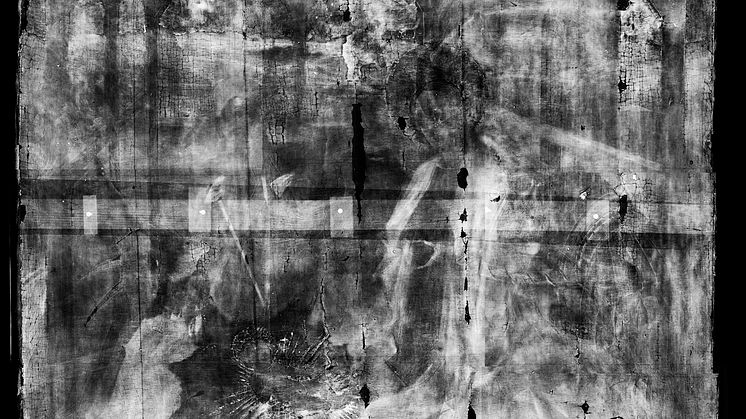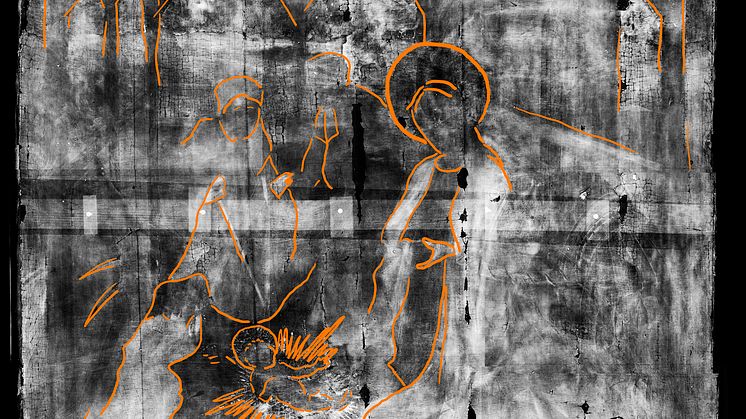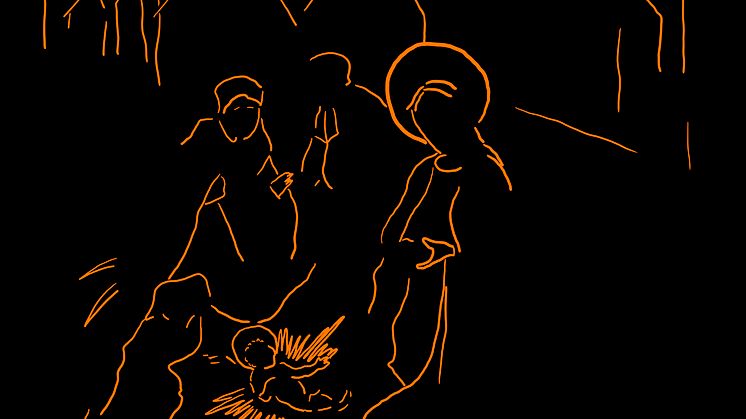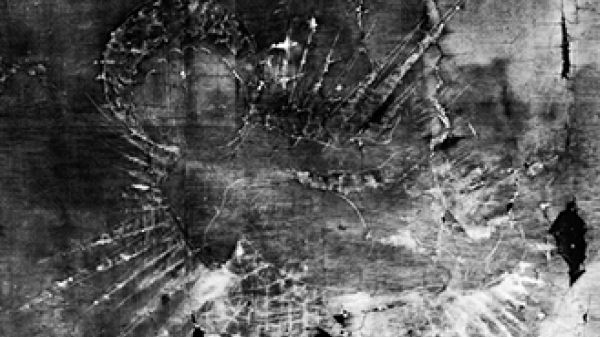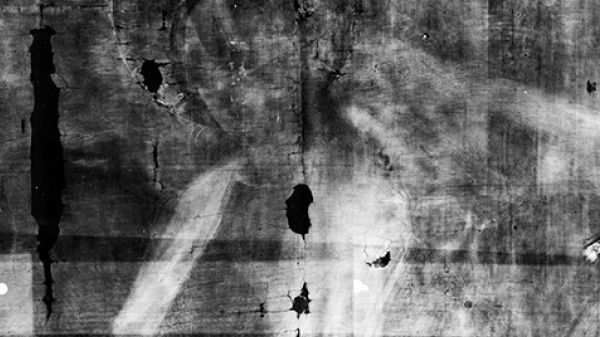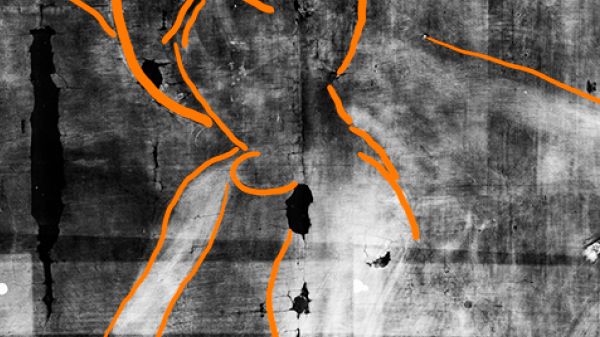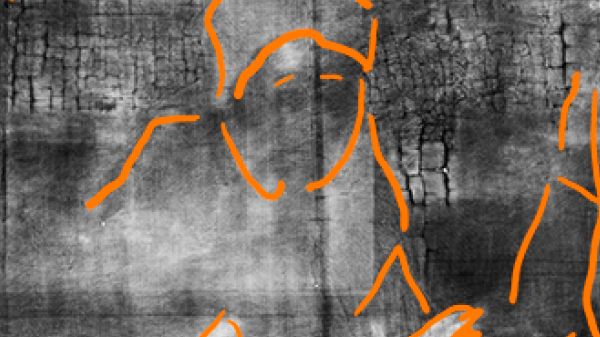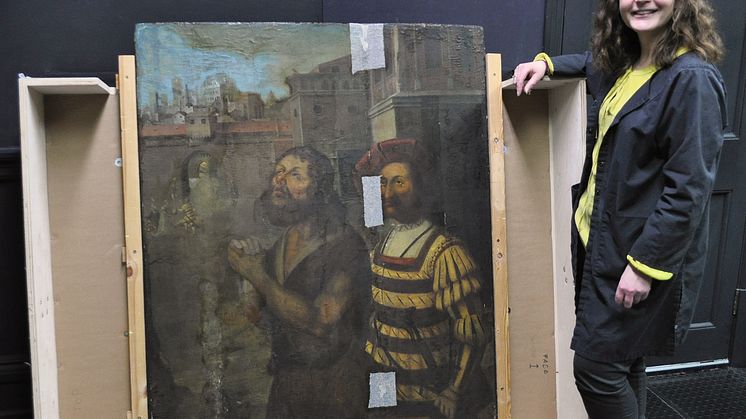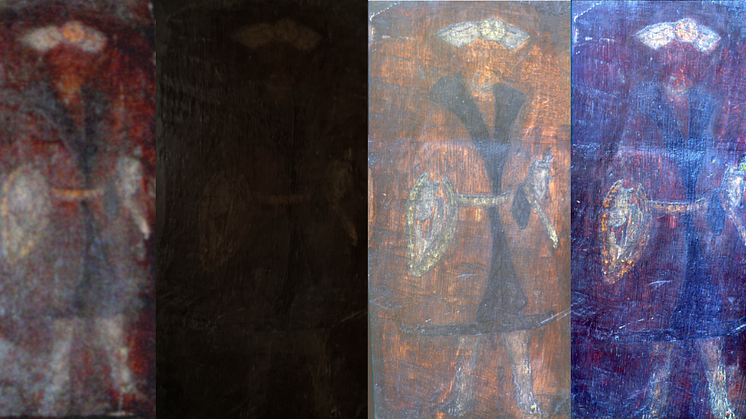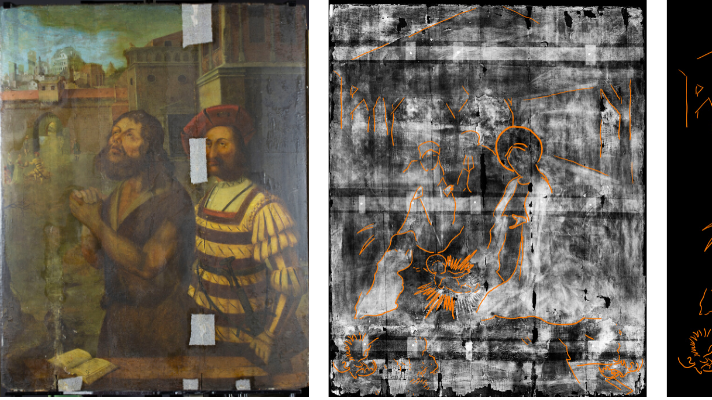
Press release -
X-ray in a manger - centuries old nativity discovered during painting investigation
Art experts have experienced something of a Christmas miracle after discovering what could be a 16th century painting of a nativity scene hidden under another work of art.
Art conservators from Northumbria University have been working with The Bowes Museum to examine a centuries-old painting depicting the beheading of Saint John the Baptist.
But they got a surprise when an x-ray of the artwork revealed another image underneath – featuring angels with halos, a baby in a manger and the outline of what appears to a stable building.
As Nicky Grimaldi, Senior Lecturer in Conservation of Fine Art at Northumbria, explains: “It was such a lovely surprise to see the nativity scene revealed underneath the painting we see today.
“It really is quite unusual to find paintings hidden in this way and to discover a nativity scene in this detail and just before Christmas was really incredible.”
The painting is believed to be around 400 years old and belongs to The Bowes Museum, having been collected by its founders John and Joséphine Bowes in the 19th century.
It is painted in a late medieval style and probably formed part of a larger altar piece. As was typical of the era it is painted onto a piece of canvas spread over a large panel made from planks of wood, usually oak, pine or even chestnut.
However, this wooden structure had deteriorated over the years, with curators at The Bowes Museum turning to experts from Northumbria’s renowned Conservation of Fine Art MA course to assess the damage.
Art Conservator Nicky Grimaldi and forensic scientist Dr Michelle Carlin, are now examining the painting to determine its age, background and history.
Nicky said: “It is clear that the painting is in a poor condition and has been for some time. The panel behind it is made up of several pieces of wood and where these join together there has been significant paint loss over the years.
“Our initial aim was to understand why this is occurring and recommend solutions to ensure the painting can be protected for years to come.
“The first stage of most investigations of this kind is to carry out an x-ray to understand what is going on underneath the layer of paint we see on the surface. That was when we realised there was more to the painting than we originally thought.”
The x-ray showed up several figures, including the outline of what appears to be one of the three wise men, or Magi – his hands outstretched as if holding out a gift.
Also clearly visible is the outline of a baby in a manger with a halo around his head. As Nicky explains: “It was common practice to apply gold leaf to these type of religious paintings and in the x-ray we can see that gold is present in the halo around the baby’s head.
“Incredibly we can see lines over the x-ray image which we believe to be preparatory drawings, showing where the painting was probably copied from an original drawing (cartoon).
“Those lines were subsequently filled with another paint layer such as lead white which allows them to be visible on the x-ray.”
There are now plans to carry out a chemical analysis of the paint used in the artwork, with small particles tested by Dr Michelle Carlin using Northumbria’s state-of-the-art equipment and techniques, including a scanning electron microscope, energy-dispersive x-ray spectroscopy and infrared reflectography.
Conservation of Fine Art MA student Sarah Linder, 23, has also been involved in the investigations and is using the painting as the subject of her dissertation.
Originally from Kentucky in the United States, Sarah’s interest in both art history and chemistry gives her the perfect background for art conservation.
She explains: “I’ve always had an interest in art, although not necessarily in being a working artist. At the same time I really enjoy science and this course at Northumbria allows me to combine those two interests.
“I have an interest in frescos and the support structures of paintings and so when Nicky started working on the panel painting from The Bowes Museum she asked me if I would like to study it too.
“It’s been incredible working on a painting of this age and the hands-on experience is invaluable – it’s what makes this course at Northumbria so unique.”
Dr Jane Whittaker, The Bowes Museum’s head of collections, said: “We’re simply delighted and astounded to discover that this 16th century work was hiding such a wonderful secret and to find out at this time of year is really quite fortuitous.It’ll be really interesting to find out more about it as Northumbria University continue their investigations.”
Northumbria University has developed an international reputation for its Conservation of Fine Arts expertise, and is one of just a handful of Universities in the UK offering a Masters qualification in the subject.
In 2011 Nicky Grimaldi hit the headlines when she discovered a portrait of Susannah Trevelyan by Thomas Gainsborough, situated at Wallington Hall in Northumberland, thought to have been over-painted by the studio assistants of his rival Sir Joshua Reynolds.
And she and Michele Carlin have both recently worked with The Bowes Museum to uncover the secret behind its paining The Death of Lucretia, believed to be by Italian Baroque painter Guido Reni, or one of his apprentices.
Find out more about Conservation of Fine Art at Northumbria.
High resolution images available to download, please scroll to the bottom of the page.
Topics
Categories
Northumbria is a research-rich, business-focused, professional university with a global reputation for academic excellence. To find out more about our courses go to www.northumbria.ac.uk
If you have a media enquiry please contact our Media and Communications team at media.communications@northumbria.ac.uk or call 0191 227 4604.








